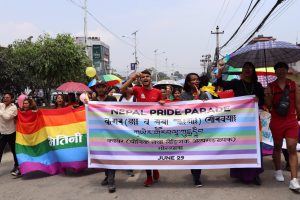On November 29, Nepal registered its first same-sex marriage between Ram Bahadur (Maya) Gurung and Surendra Pandey. With this, the country has become the second in Asia — after Taiwan — to formally register a same-sex marriage.
The registration occurred in Dordi Rural Municipality in Lamjung district after the Supreme Court issued an interim order to register same-sex marriages and keep temporary marriage records.
Activists hailed the Supreme Court’s decision. Sunil Babu Pant, an openly gay former parliamentarian and former executive director of Blue Diamond Society, said, “[T]the pivotal aspect lies in the recognition of marriage with identity, paving the way for other couples.” Blue Diamond Society is an organization that advocates for LGBT rights in Nepal.
The decision is the culmination of a series of progressive verdicts by Nepal’s judiciary. In 2007, Nepal’s Supreme Court ordered the government to recognize a third gender category, audit all laws that discriminate against LGBT people, and form a committee to study legal recognition of same-sex relationships. By 2010, the Election Commission and immigration forms added the option of “other” in addition to male and female, legally recognizing a third gender category. In 2011, Nepal became the first country globally to include a third gender in its census. Nepal started issuing passports that recognized the third gender in 2015. The Constitution of Nepal, 2015 protects sexual minorities.
The judiciary deserves a pat on the back for its progressive approach. The 2007 ruling of the Supreme Court was a critical milestone recognizing LGBT rights as fundamental human rights. The apex court directed the government to formulate a law for same-sex marriage in 2015 based on the study committee mandated in the 2007 ruling. A year earlier, the Supreme Court directed the government to issue a non-tourist visa, similar to the one granted to heterosexual spouses of Nepali citizens, to Tobias Volz, the same-sex partner of Adheep Pokharel. Earlier in June, the top court issued an interim order to the Nepali government to recognize same-sex marriage by allowing same-sex couples and other non-heterosexual couples to register their marriage.
However, the progress was neither smooth nor linear. Despite the top court’s direction, the new Civil Code 2017 says that a marriage can be concluded when a “man and woman accept each other as the husband and wife” established to start conjugal and family life. Two lower courts had rejected Gurung and Pandey’s application to register a marriage, basing their decision on the Civil Code.
The political leadership deserves credit, albeit qualified, too. The provisions in the constitutions are progressive, in general, and recognize the rights of the third gender. However, the government and the political leaders have shown “lazy support” at best or willful ignorance at worst in its implementation. Despite the Supreme Court-mandated committee recommending allowing all forms of marriage in 2015, the Civil Code defined marriage narrowly as one between a man and a woman. It did not grant Volz the non-tourist visa until it was directed to do so by the Supreme Court.
The struggle for equality and representation does not end here. The order by the Supreme Court is interim, and the registration is temporary. The Civil Code needs to be amended to define marriage more inclusively and straighten out the discrepancies between the provisions of equality in the Constitution and the Civil Code. Not all bureaucrats or elected officials will be as welcoming as those in the Dordi Rural Municipality, nor will all other couples have the means to take their case to the Supreme Court.
Nepali society poses another challenge. While the attitudes in Nepal have changed rapidly in the last two decades, society remains largely conservative. The two lower court judges denied their marriage registration despite the Supreme Court’s June verdict. A judge at the Kathmandu District Court denied Gurung and Pandey’s request, citing the Civil Code, and Patan High Court upheld the district court’s ruling in October. Pant called the judges “prejudiced and conservative.”
Nepal’s 2021 census lists just 2,928 people under the sexual and gender minorities category, a mere 1 in 10,000 people. However, various studies have shown that 2 percent of people globally identify as such. This shows that a large number of sexual minorities in Nepal are reluctant to identify as such because of the social stigma despite the progress made by Nepal in recent decades.
In saying that, this is a milestone in LGBT rights in the right direction. Nepal has developed a reputation as a “global LGBT rights beacon,” and same-sex marriage registration furthers the narrative.
It comes at a critical time in Nepal and the global environment. The progressive zeal that Nepali political parties had since the end of the Maoist insurgency in the early 2000s has declined, but the resurgence of social conservatism that has dogged inclusive policies in countries worldwide has yet to reach Nepal.
In the neighborhood, the Indian Supreme Court dragged its feet in a ruling last month to say that “it was the legislature, and not the Court, to formally recognize and grant legal status to non-heterosexual relationships.”
Therefore, Nepal’s judiciary deserves credit and has set an example for other judiciaries. At the same time, the government and the parliament must step up to make necessary changes in the laws to ensure that the right is implemented and accessible. There is a long way to go for LGBT equality in the true sense, but Nepal’s step is in the right direction and injects new hope into the fight.

































